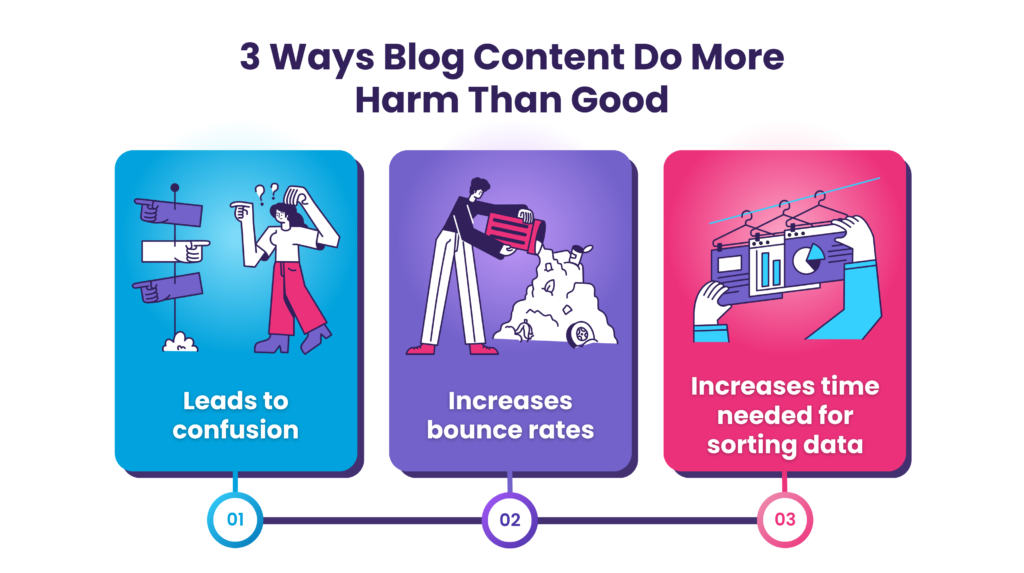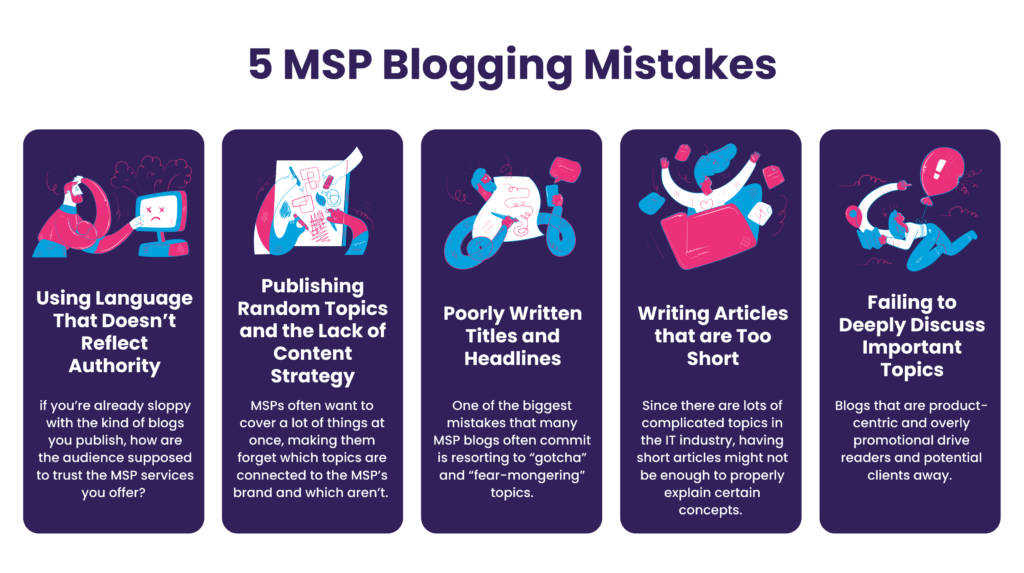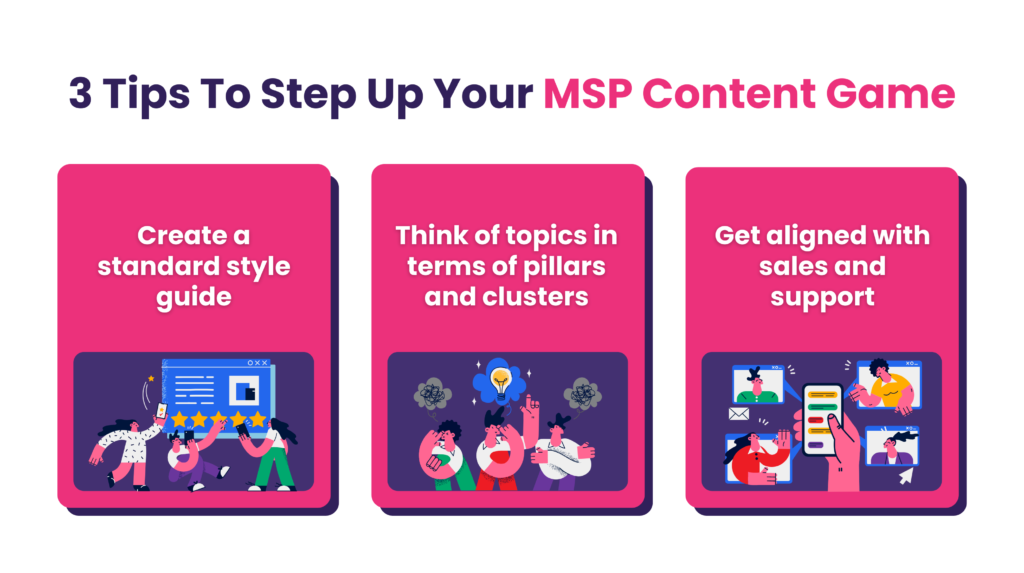Menu

While MSPs are essential in managing IT systems in other industries, they often find it difficult to build a community and strengthen relationships with their target audience. Blogging is one of the best ways for MSPs to attract engagements, but they don’t always yield the desired results – especially for MSP blogs that publish off-brand content.
There are lots of topics to cover in your MSP blog and it’s normal to slip up occasionally. But when you commit too many mistakes too often, search engines and audiences start to notice these slip-ups and ignore your blog in favor of more reliable and valuable content.

Blogging is an effective way to generate traffic to a website. Brands and businesses that write good content can experience as much 55% increase in site traffic compared to other companies that don’t utilize blogs and content creation. In an ideal world, every blog you publish would be related to how well your services are sold.
However, this isn’t always the case – having an off-brand blog that isn’t directly related to the MSP service you provide can even do more harm than good. The content may only be tangentially related, but it’s not enough to push readers to make the purchase or contact the MSP company soon. Most of the traffic will never convert – audiences only tend to read the blog and leave once they get the information they need.
Increased site traffic is only a good thing if it’s qualified. Otherwise, it may only have negative consequences that hinder the MSP’s goals. Here are the ways that unqualified blog content does more harm than good:

Bad blog content can hurt your ranking because both human readers and search engines tend to ignore it. Unfortunately, a lot of MSP companies don’t even realize what they’re doing wrong with their blog.
If you’re convinced that you’re doing nearly everything right, but your blogs still aren’t attracting the right attention, then you might be unconsciously committing these MSP blogging mistakes:
Nobody trusts or wants to read sloppy content. This kind of content can even hurt your SERP ranking because it means you’re not publishing reliable information that audiences can use. It also sends the wrong impression to potential clients – if you’re already sloppy with the kind of blogs you publish, how are they supposed to trust the MSP services you offer?
The IT industry is constantly changing, so some people might find it hard to keep up with the latest IT infrastructures and systems. As an expert in the industry, MSPs should be familiar with these latest developments. Blogging is a good way to show readers how knowledgeable the MSP is on a certain topic, but many of them forget to fact-check sources and look up the latest information before publishing.
Aside from including accurate information about a topic, MSPs also struggle with using the right language. Many of them fail to simplify complex concepts in a way that audiences understand, while others tend to sound condescending by overly dumbing down their content. Some of them even forget about proofreading and their material ends up getting published with tons of typos and grammatical errors.
Having a lot of topics to write about is a double-edged sword: it gives MSP blogs a lot of options about what to write, but it also makes them lose focus on what they should be talking about. They often want to cover a lot of things at once, making them forget which topics are connected to the MSP’s brand and which aren’t.
Publishing multiple blog posts now and then gives MSPs the illusion that their content is doing what it should, but this might not be true in most cases. MSP blog posts might do well individually, but they don’t contribute to building brand authority without a clear strategy.
Without a niche to talk about, MSPs lose their brand credibility with every random blog post they publish. It also reflects their indifference to content quality, making the audience confused about the brand identity and how they should interact with the brand. This also results in a low SERP ranking because the published blog isn’t considered credible by search engines.
Titles and headlines are meant to be intriguing and catchy, but they should still be accurate. One of the biggest mistakes that many MSP blogs often commit is resorting to “gotcha” and “fear-mongering” topics.
Audiences are reading blogs to know more about a topic, so they should be enticed when they see the title. Fear-mongering blog titles can be dangerous because they exaggerate information to simply make the content “clickable.” It also contributes to the amount of false information available on the web. When readers find out that the danger isn’t real after reading the blog, they might feel disappointed because they didn’t find the right value that the blog promised.
Another example of poorly written headlines are long titles like “Hackers Are Getting Smarter - How Do You Keep Your Business Computer From Getting Hacked.” They take longer to read and comprehend, which might turn audiences off before they even have a chance to open the link. Ideally, blog titles should only be around 50 to 60 characters long.
On the other hand, having titles that are too short with only a few words is also a bad practice. For example, simply writing “QR Codes Tips” as a blog title isn’t recommended because it’s incomplete. It doesn’t help the reader understand what the intention behind the content is or how it provides value to them.
Aside from the language and topic of MSP blogs, it’s also essential to consider the length of each piece of content. Since there are lots of complicated topics in the IT industry, having short articles might not be enough to properly explain certain concepts to audiences.
Shorter content that’s less than1000 words has its own purpose and attracts its own demographic, but longer articles perform better when it comes to MSP blogs. Search engines love longer posts so they’re more likely to perform better than shorter articles. Having longer articles also gives MSP blogs a chance to attract more shares and links.
Audiences read MSP blogs to find important information they need to help them decide or make a purchase. However, some MSPs forget this important detail and only use their blog as an avenue to brag and talk about their products and services.
Blogs that are product-centric and overly promotional drive readers and potential clients away. Instead of focusing on simply selling products or services, MSP blogs should write educational content related to their brand and what they offer.
Each written content should deeply discuss the important topics that readers need to know about. Even if readers don’t make the purchase right away, they’re still more likely to remember the MSP blog that helped them out and contact them when they need IT services.

The good news is that even bad MSP blogs can still be saved with the right steps. You don’t have to start from scratch if you start following these tips as soon as you understand what went wrong with your MSP blog:
Blogging is one of the best ways for MSP brands to educate and connect with their audience, but it’s more than just about publishing tech-related content. If you’re unsure how to start your MSP blog or upgrade it, find a team to help you create the best on-brand content with just a few clicks.
There’s power in storytelling and how it isn’t just limited to creative companies. Even MSPs can speak to their audiences on a personal level with the right content. Make sure that you recruit a team of content ecosystem professionals that will help you create a unique connection to your target audience through blogs and other types of content.